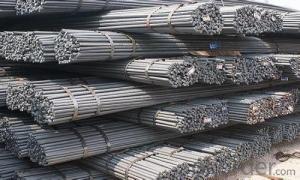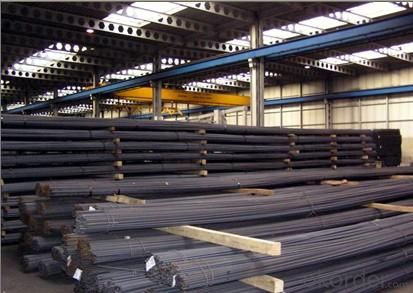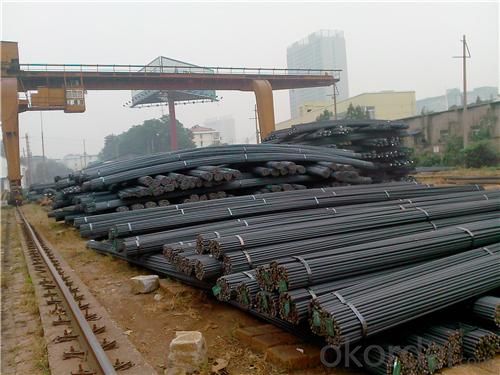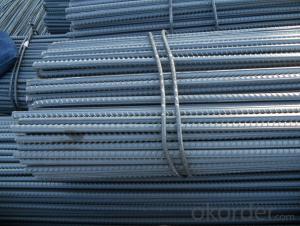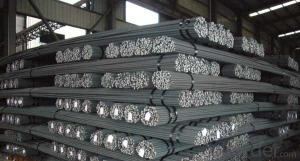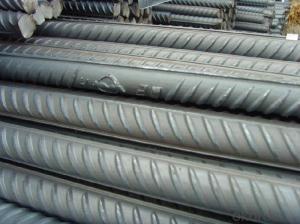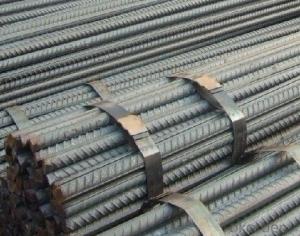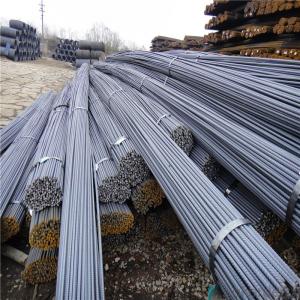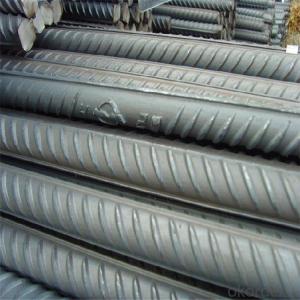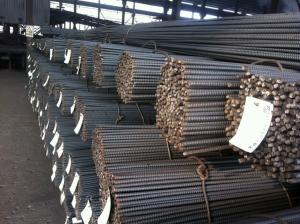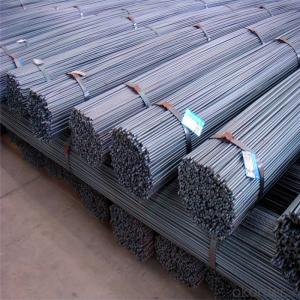HDC stainless deformed steel bar for construction
- Loading Port:
- Tianjin
- Payment Terms:
- TT OR LC
- Min Order Qty:
- 25 m.t.
- Supply Capability:
- 100000 m.t./month
OKorder Service Pledge
OKorder Financial Service
You Might Also Like
Specifications of Construction Steel Round Bar
1. Grade: Q195, Q235, A36, SS400, Q345
2. Material: Mild carbon steel
3. Diameter: 8mm-150mm
4. Length: 6m, 9m, 12m
5. Quenching methods: oil quenching, air cooling or salt bath quenching
6. Heat treatment: Isothermal annealing temperature is 800~880 °C, with 10~20 °C, the furnace cooling to about 600 °C
Usage and Applications of Construction Steel Round Bar
1. Construction steel round bar is mostly used for straight bundles supply, and used for steel, bolts and various mechanical parts. While the bigger round bar, or more than 25mm hot rolled bar, is mainly for the manufacture of mechanical parts or for seamless steel billet.
2. Steel round bar is used in construction and a large number of architectural and engineering structures.
3. Besides, we can supply some especial material steel round bar that can be used for main shaft of steamer, hummer shank, with big section and supper force.
Production Flow of Mild Steel Round Bar
EAF+LF+VD+ Forged+ Heat Treatment
Material prepare (billet) — heat up — rough rolling — precision rolling — cooling — packing — storage and transportation
Quality Assurance of Mild Steel Round Bar
1. We will strictly inspect our production that we sold according to the customer’s request.
2. Our steel reaches international quality standards.
3. Quality should be in conformity with the specification of the manufacturer. Quantity and packing conditions should be in conformity with the term in the contract.
4. Should the packing found damaged, the buyer has the right to claim to the seller.
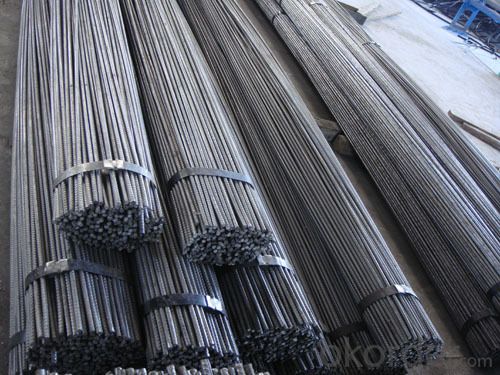
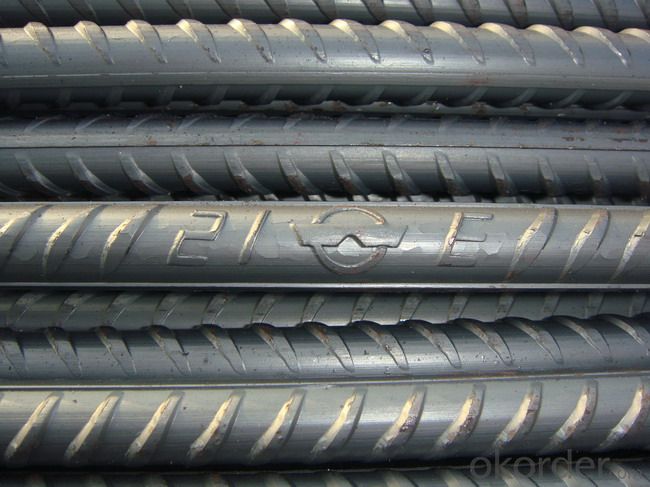
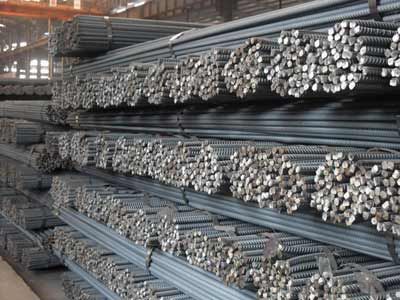
- Q: Can steel rebars be used in cold weather conditions?
- Yes, steel rebars can be used in cold weather conditions. Steel has excellent cold weather performance and can maintain its structural integrity even in extremely low temperatures. However, it is important to ensure that proper construction practices are followed, such as protecting the rebars from moisture and using appropriate concrete curing methods to prevent freezing and cracking.
- Q: How are steel rebars protected against corrosion?
- Steel rebars are protected against corrosion through various methods such as applying a protective coating, using corrosion inhibitors, cathodic protection, and ensuring proper concrete cover to prevent exposure to moisture and aggressive chemicals.
- Q: How do steel rebars affect the overall aesthetics of a building?
- Steel rebars do not have a direct impact on the overall aesthetics of a building as they are typically concealed within the concrete structure. However, their presence is crucial for structural integrity and ensuring the building's safety, which indirectly contributes to the overall aesthetics by allowing for more creative and innovative architectural designs.
- Q: Can steel rebars be used in combination with other reinforcement materials?
- Yes, steel rebars can be used in combination with other reinforcement materials in construction projects. Steel rebars are commonly used in reinforced concrete structures to provide tensile strength and enhance the overall structural integrity. However, in some cases, additional reinforcement materials may be required to meet specific design requirements or address unique construction challenges. For instance, in high seismic areas, where flexibility and ductility are crucial, steel rebars can be combined with other materials such as fiber-reinforced polymer (FRP) bars or carbon fiber-reinforced polymer (CFRP) strips. These materials offer enhanced strength and flexibility, helping to improve the structure's resistance to seismic forces. Moreover, in situations where corrosion is a concern, steel rebars can be used in combination with corrosion-resistant materials like stainless steel rebars or epoxy-coated rebars. These materials create a protective barrier, preventing the steel rebars from coming in direct contact with moisture and corrosive agents. Additionally, in some specialized applications such as precast concrete elements or composite structures, steel rebars can be used alongside other reinforcement materials like prestressed tendons or structural fibers. This combination allows for the redistribution of loads and ensures optimal structural performance. In summary, steel rebars can be effectively combined with other reinforcement materials to meet specific construction requirements, enhance structural performance, and address challenges related to seismic activity, corrosion, or specialized applications.
- Q: How do steel rebars help in preventing cracks in concrete structures?
- Steel rebars help in preventing cracks in concrete structures by providing reinforcement and increasing the tensile strength of the concrete. Concrete is strong in compression but weak in tension. When exposed to forces that cause tension, such as bending or stretching, concrete tends to crack. Steel rebars, which are embedded within the concrete, act as a support system and resist the tensile forces, preventing or minimizing cracks. The rebars distribute the stress across the structure, enhancing its overall durability and preventing failure.
- Q: How do steel rebars contribute to the overall sustainability of concrete structures?
- Concrete structures benefit from the presence of steel rebars in various ways, thereby contributing to their overall sustainability. To start with, the durability and lifespan of concrete structures are significantly enhanced by steel rebars. By reinforcing the concrete, rebars provide additional strength and prevent cracks or structural failures, thereby extending the structure's life. This reduces the need for frequent repairs or replacements, conserving resources and minimizing the environmental impact of construction activities. Furthermore, steel rebars are entirely recyclable. When a structure reaches the end of its life cycle, the rebars can be easily extracted and recycled, reducing the demand for new raw materials and minimizing waste. This not only conserves natural resources but also reduces greenhouse gas emissions associated with the extraction and production of fresh steel. Incorporating steel rebars into concrete structures also allows for the use of thinner concrete sections. By using less concrete, the demand for cement, a significant source of carbon dioxide emissions during production, is reduced. Therefore, the use of steel rebars helps to lower the overall carbon footprint of concrete structures. Moreover, steel rebars can be designed to resist corrosion, which is a common problem in concrete structures exposed to harsh environments or coastal areas. By providing protection against corrosion, the rebars increase the service life of the structure, reducing the need for maintenance and repairs. This not only saves costs but also reduces the environmental impact associated with maintenance activities. In conclusion, steel rebars play a vital role in enhancing the sustainability of concrete structures by improving their durability, enabling recycling, reducing material consumption, and minimizing maintenance requirements. By incorporating steel rebars into concrete construction, we can create long-lasting, environmentally-friendly structures that contribute to a more sustainable built environment.
- Q: What is hot rolled coil? Hot rolled coil relative to thread steel and other steel, is not considered a higher point?
- The thread steel is a long piece of steel pulled out at a certain temperature.There is no high or no advanced problem between the two.
- Q: What are the safety measures to consider while handling steel rebars?
- When handling steel rebars, there are several safety measures that should be considered to minimize the risk of accidents or injuries. These measures include: 1. Personal Protective Equipment (PPE): Always wear the necessary PPE, which may include safety glasses, steel-toe boots, gloves, and a hard hat. This will protect you from potential hazards such as falling rebars, sharp edges, or flying debris. 2. Proper Lifting Techniques: When lifting rebars, use proper lifting techniques to avoid straining your back or causing injury. Bend your knees, keep your back straight, and lift with your leg muscles, rather than your back. 3. Secure Storage: Store steel rebars in a secure and organized manner to prevent them from falling or rolling onto someone. Stack them in a stable manner and use support structures if necessary. 4. Communication and Signage: Ensure clear communication between workers involved in rebars handling. Use hand signals or verbal cues to avoid accidents. Additionally, place safety signs or warning labels in the area to indicate potential hazards or restricted access. 5. Proper Tools and Equipment: Use appropriate tools and equipment specifically designed for handling steel rebars. This may include lifting clamps, rebars benders, or cutting tools. Inspect and maintain these tools regularly to ensure their proper functioning. 6. Inspection and Removal of Defective Rebars: Inspect steel rebars for any defects, such as cracks, rust, or damage, before using them. Defective rebars should be removed and replaced with new ones to ensure structural integrity. 7. Secure Work Area: Maintain a clean and clutter-free work area to prevent tripping hazards and provide enough space for maneuvering. Keep the work area well-lit and free from obstacles or other potential hazards. 8. Training and Supervision: Provide proper training to workers involved in handling rebars, ensuring they are aware of the safety protocols and best practices. Regularly supervise their work to identify any unsafe practices and provide guidance or corrective actions. By following these safety measures, the risk of accidents and injuries while handling steel rebars can be significantly reduced, resulting in a safer work environment.
- Q: Can steel rebars be used in structures with limited construction regulations?
- Yes, steel rebars can be used in structures with limited construction regulations. Steel rebars are commonly used in construction due to their high tensile strength and durability. However, it is important to note that even in structures with limited regulations, it is crucial to follow basic safety guidelines and ensure proper engineering and construction practices to ensure the structural integrity and safety of the building.
- Q: What are the common challenges in handling steel rebars during construction?
- Construction often presents numerous obstacles when it comes to managing steel rebars. One primary hurdle involves the weight and size of the rebars themselves. These metal rods can be quite cumbersome and unwieldy, making it challenging to lift and manipulate them on the construction site. Failing to employ appropriate lifting techniques and equipment can result in worker injuries. Another issue concerns the storage and organization of rebars. Given the various lengths and sizes they come in, it becomes crucial to maintain a well-organized storage area that keeps them separate and easily accessible. Neglecting to do so can lead to construction delays and inefficiencies. Moreover, steel rebars are prone to rust and corrosion if mishandled or stored improperly. Exposing them to moisture, rain, or excessive humidity can cause deterioration, which weakens structures. Therefore, it is vital to safeguard rebars from these elements and store them in a dry, well-ventilated space. Additionally, placing and aligning rebars within concrete structures poses a challenge. This task demands skilled labor and precision to ensure that rebars are correctly positioned according to construction plans. Any errors in placement can compromise the building's structural integrity, leading to safety concerns and expensive repairs. Finally, transporting rebars to the construction site poses a logistical challenge. Coordinating their delivery and ensuring they arrive on time and in the required quantities can be complex, especially in large-scale projects. Delays in receiving rebars can result in project delays and additional costs. In conclusion, effectively managing steel rebars during construction necessitates careful planning, proper storage, skilled labor, and adherence to safety protocols. By addressing these common challenges, construction projects can ensure the successful and efficient utilization of steel rebars.
Send your message to us
HDC stainless deformed steel bar for construction
- Loading Port:
- Tianjin
- Payment Terms:
- TT OR LC
- Min Order Qty:
- 25 m.t.
- Supply Capability:
- 100000 m.t./month
OKorder Service Pledge
OKorder Financial Service
Similar products
Hot products
Hot Searches
Related keywords
